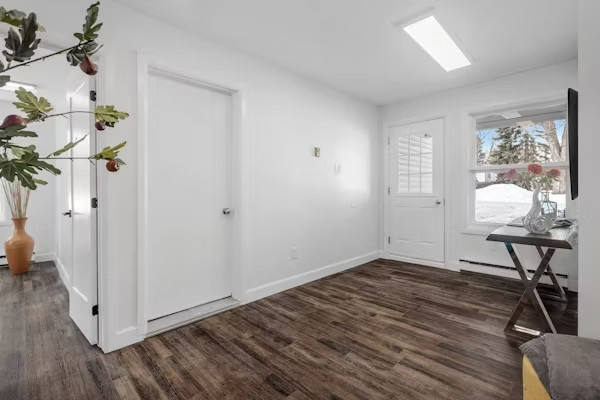Luxury vinyl flooring is trendy due to its affordability, durability, and stylish appearance. Luxury Vinyl Plank (LVP) and Luxury Vinyl Tile (LVT) are two of the most popular luxury vinyl flooring options. While both options provide many of the same benefits, there are some key differences that may influence your decision depending on your specific requirements.
In this article, we’ll explore the differences between LVP and LVT, their pros and cons, and how to choose the right option for your space.
What is Luxury Vinyl Flooring?
Before diving into the specific differences between LVP and LVT, it’s important to understand what luxury sheet vinyl flooring is as a whole.
Luxury vinyl is a synthetic flooring material that resembles natural materials such as wood or stone. It consists of multiple layers, including a tough protective wear layer that resists scratches and stains and a photographic layer that gives the floor a realistic appearance. Below this, there’s a durable core layer, and some options even include an attached underlayment for added comfort and sound insulation.
Luxury Vinyl Plank (LVP): Features and Benefits

Luxury Vinyl Plank (LVP) is intended to mimic the appearance of hardwood flooring. With various styles that mimic wood species such as oak, maple, and walnut, LVP is ideal for homeowners who appreciate the warmth and classic beauty of wood but want a more affordable and low-maintenance option.
Key Features of LVP:
- Wood-Like Appearance: LVP comes in plank sizes that resemble traditional hardwood, complete with realistic textures and grain patterns.
- Durability: It is highly resistant to water, stains, and scratches, making it ideal for high-traffic areas, pet-friendly homes, and moist environments such as kitchens and bathrooms.
- Easy Installation: Many LVP options include a click-lock installation system, making them DIY-friendly.
- Comfort Underfoot: Because of its layered construction, LVP is softer underfoot than hardwood or tile, providing some extra comfort while walking.
Pros of LVP:
- Realistic wood-like appearance at a fraction of the cost of hardwood.
- Excellent water resistance, making it suitable for bathrooms, kitchens, and basements.
- Low maintenance and easy to clean.
- Available in various thicknesses and wear layers for enhanced durability.
Cons of LVP:
- It may not fully replicate the luxurious feel of real wood.
- Requires careful installation to avoid gaps or uneven surfaces.
- Lower-end LVP options may show wear and tear more quickly over time.
Luxury Vinyl Tile (LVT): Features and Benefits

Luxury Vinyl Tile (LVT) is intended to mimic the appearance of stone, ceramic, or porcelain tiles. If you like the sleek, elegant look of stone flooring but want something that is easier to maintain and less expensive, LVT is an excellent option.
Key Features of LVT:
- Tile-Like Design: LVT comes in square or rectangular tiles that resemble marble, travertine, or slate.
- Durability: Like LVP, LVT is waterproof and scratch resistant, making it an excellent choice for areas where moisture and wear are an issue.
- Styles: LVT comes in a variety of colors and designs, including highly detailed stone looks that are nearly identical to the real thing.
- Versatility: LVT is versatile and can be installed with or without grout, depending on the desired look.
Pros of LVT:
- Provides the sophisticated, natural look of stone or ceramic at a much lower cost.
- Warmer and more comfortable underfoot than real tile.
- Highly durable and water-resistant.
- Easier to install than real stone or ceramic tiles.
Cons of LVT:
- While it mimics the look of stone, it doesn’t offer the same cold, hard feel, which may be a downside for those who prefer that aesthetic.
- Just like LVP, lower-quality LVT may not last as long.
- It can still feel slightly artificial in comparison to the authentic stone or ceramic it’s imitating.
Key Differences Between LVP and LVT
While LVP and LVT have many similarities, such as durability, water resistance, and ease of installation, their primary distinction is in their aesthetic appeal and form factor.
1. Appearance and Style
- LVP is designed to resemble hardwood flooring, with planks that replicate the natural grain and texture of wood.
- LVT replicates stone, ceramic, or porcelain tiles, providing a sleek, sophisticated look that’s more suitable for contemporary or modern spaces.
2. Shape and Size
- LVP typically comes in longer, narrow planks, similar to traditional hardwood flooring.
- LVT is available in square or rectangular tiles, designed to mimic the shape and style of stone or ceramic tiles.
3. Installation
LVP and LVT are both available in click-lock systems as well as glue-down products, providing installation flexibility based on the preferred method. LVT, on the other hand, can be installed with or without grout, giving you more control over the final look.
4. Comfort Underfoot
Both are softer than real wood or stone, but LVP is particularly comfortable due to its plank format and underlayment options. LVT, while softer than stone, may feel firmer because of its tile-like design.
Choosing Between LVP and LVT: Factors to Consider

1. Room Type
- LVP is ideal for living rooms, bedrooms, and other spaces where the warm, natural look of wood is desirable.
- LVT is a great option for bathrooms, kitchens, or entryways where a stone or ceramic appearance may be more fitting.
2. Budget
- LVP and LVT are generally less expensive than hardwood or natural stone, though prices can vary depending on product quality. LVP is usually slightly more expensive due to the added complexity of replicating wood textures.Keep the floors looking their best.
3. Maintenance Needs
Both LVP and LVT are simple to maintain and clean, making them ideal for families with children or pets. Sweeping and occasional mopping are usually sufficient to keep these floors looking their best.
4. Aesthetic Preferences
- If you prefer the natural warmth and classic look of wood, LVP is the way to go.
- If you lean toward the modern, sleek appearance of stone or tile, then LVT is your best bet.
Final Thoughts
When deciding between Luxury Vinyl Plank (LVP) and Luxury Vinyl Tile (LVT), consider the look and feel you want in your space. Both are long-lasting, water-resistant, and cost-effective alternatives to hardwood and stone, but their appearance and design flexibility make them appropriate for different environments and preferences. Whether you want to recreate the rustic charm of wood or the sleek elegance of stone, luxury vinyl flooring is a versatile option for any home.

